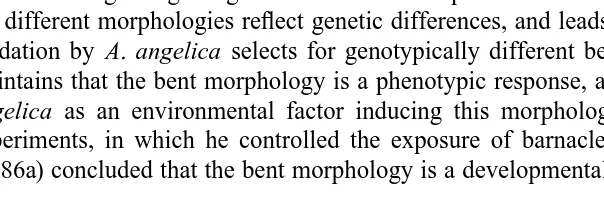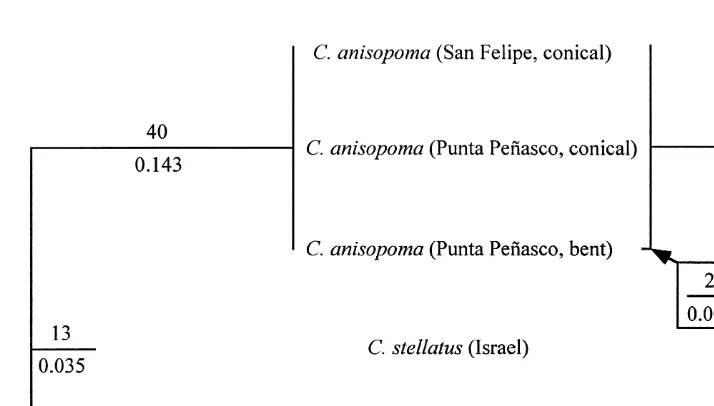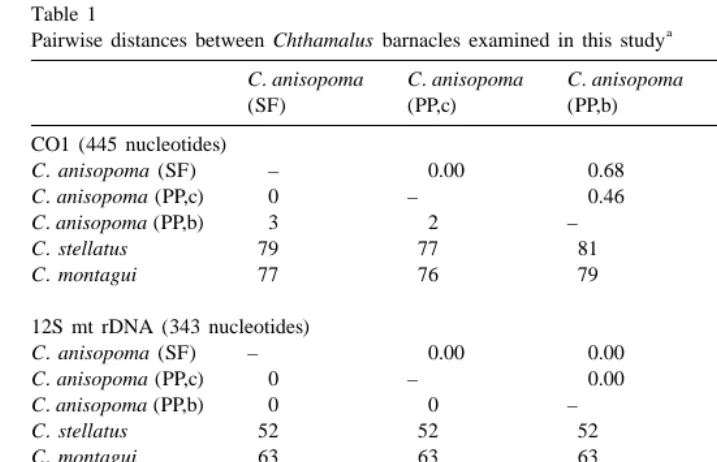L
Journal of Experimental Marine Biology and Ecology 243 (2000) 295–304
www.elsevier.nl / locate / jembe
The different morphs of Chthamalus anisopoma: a
phenotypic response? Direct molecular evidence
a ,* b b b
O. Mokady , L. Mizrahi , R. Perl-Treves , Y. Achituv
a
Institute for Nature Conservation Research, The George S. Wise Faculty of Life Sciences,
Tel Aviv University, Tel Aviv 69978, Israel b
The Faculty of Life Sciences, Bar Ilan University, Ramat Gan 52900, Israel Received 7 July 1999; accepted 13 August 1999
Abstract
Chthamalus anisopoma is a rock-inhabiting barnacle which appears in two radically different morphs: the shell may be either conical or bent at a right angle. Based on field experiments, it was previously concluded that the two morphs are phenotypic variants, with the bent morph being induced by the presence of a predator gastropod. In the present study we used molecular data in order to examine directly the degree of genetic similarity between the two morphs. We compared the sequences of two mitochondrial DNA segments previously shown to exhibit substantial inter-and intra-specific variability in barnacles: the 12S mt rDNA inter-and the cytochrome C oxidase subunit 1 (CO1). The sequences obtained for the different C. anisopoma morphs showed complete identity
(12S rDNA) or very high similarity (.99.5%, CO1). We thus provide direct genetic evidence
indicating that barnacles of the different morphs originate from a common gene pool. This supports previous conclusions that predation in this case is an inductive factor rather than
selective. 2000 Elsevier Science B.V. All rights reserved.
Keywords: Cirripedia; mt DNA; Phenotypic induction; Selection
1. Introduction
Within-species morphological variability exhibited by different organisms may reflect different levels of genetic differences, such as those arising between isolated populations along the process of speciation. On the other hand, the same variability may be the result of environmental factors, such as differences between or within the habitat. Shell
*Corresponding author: Tel.: 1972-3-640-6358; fax: 1972-3-640-7304.
E-mail address: mokady@post.tau.ac.il (O. Mokady)
296 O. Mokady et al. / J. Exp. Mar. Biol. Ecol. 243 (2000) 295 –304
morphology in cirripeds demonstrates considerable plasticity, and was already described and discussed by Darwin (1854). Since shell morphology has traditionally been a major component in cirriped taxonomy, it may have caused classification errors because of superficial similarity and dissimilarity: either the lumping of genetically distinct barnacles into one species or separation of genetically similar barnacles into distinct species.
The rock-inhabiting barnacle Chthamalus anisopoma is an example of taxonomic difficulties arising from shell morphology. Lively (1986a,b) described two morphologi-cal varieties of C. anisopoma from the Gulf of California, exhibiting strikingly different shell morphology. One is a typical conical morph that has a volcano shaped shell and the other is an atypical, bent morph, in which the rim of the shell aperture is in a plane perpendicular to the base (Fig. 1). The conical morph is found throughout the Gulf of California (Newman and Ross, 1976) while the bent morph is restricted to the northern part of the Gulf. The bent morph is more abundant near crevices in rocks.
Lively (1986a) showed that the bent morph is more resistant to predation by the carnivorous snail Acanthina angelica than the conical one. This snail occupies the upper part of the ‘barnacle zone’ in the northern part of the Gulf of California, but is rare or absent from the central and southern part of the Gulf (Lively, 1986a). A. angelica is a barnacle-eating specialist (Paine, 1966). It tends to remain in refuges in crevices and under boulders during high tides (possibly to avoid fish predation), but forages out of the exposed refuges at low tides (Lively, 1986a). Field experiments suggest that predation by A. angelica on barnacles is most intense in the vicinity of crevices (Lively, 1986a). Thus, the observed distribution pattern of the different C. anisopoma morphs may be associated with that of A. angelica.
On the basis of the above information, Lively (1986a,b) examined two alternative hypotheses regarding the genetic basis of dimorphism in C. anisopoma. One claims that the different morphologies reflect genetic differences, and leads to the interpretation that predation by A. angelica selects for genotypically different bent individuals. The other maintains that the bent morphology is a phenotypic response, and views predation by A.
angelica as an environmental factor inducing this morphology. On the basis of field
experiments, in which he controlled the exposure of barnacles to the predator, Lively (1986a) concluded that the bent morphology is a developmental response to the presence
of A. angelica. The default developmental pathway leads to conical morphology, and exposure to A. angelica induces the change to bent shell morphology. Thus, individuals exhibiting the different morphologies are not genetically distinct.
The advent of modern molecular techniques allows for direct estimates of genetic similarity. Specifically, the development of the polymerase chain reaction (PCR) technology enables easy access to specific segments of DNA. Two segments of mitochondrial (mt) DNA were previously reported as useful for detecting differences at the species and sub-species levels in barnacles, and were therefore selected for the current study. These segments are sufficiently variable for the analysis, and are flanked by sufficiently conserved regions to serve as PCR primers. Van Syoc (1994, 1995) used a segment of the cytochrome C oxidase subunit 1 (CO1) to determine the genetic relationships among populations of Pollicipes elegans from the western coasts of America. Hasegawa et al. (1996) used the same gene for comparison of related species of Tetraclita. Mokady et al. (1999) used 12S rDNA for inter- and intra-specific comparisons of coral-inhabiting barnacles from different coral hosts. In the present study, we used these two mtDNA segments to detect genetic differences between the conical and bent morphs of Chthamalus anisopoma.
2. Materials and methods
2.1. Animal collection
Chthamalus anisopoma barnacles were collected at two sites in the Northern Gulf of
California. Barnacles featuring the conical morph were collected from two sites: San Felipe, on the Western coast of the Gulf of California, and Punta Pelicano near Punta
˜
Penasco on the Eastern coast. Barnacles exhibiting the bent morph were collected from the latter site, which is the site used by Lively (1986a,b) for his field study.
Two additional Chthamalus species were collected in order to serve as outgroups in the analyses. C. stellatus was collected along the shores of Israel and C. montagui was collected near Rabat, Morocco.
2.2. DNA preparation, amplification and sequencing
DNA was prepared from alcohol-preserved specimens according to the protocol used by Mizrahi et al. (1998). Five to eight individuals of each population were pooled for DNA extraction. Fifty ng DNA were used as a template for PCR amplification. The CO1
fragment was amplified by primers synthesized according to Van Syoc (1994): 59
-GAGCTCCAGATATAGCATTCC and 59-TGAGAAATTATTCCGAAGGCTGG. The
amplification reaction consisted of an initial denaturation step of 2 min at 948C, followed by 40 cycles of 1.5 min at 948C, 2 min at 428C and 2 min at 728C, and a final elongation
of 7 min at 728C. The 12S rDNA fragment was amplified using the primers of Mokady
et al. (1994; modified from Kocher et al., 1989): 59-GAAACCAGGATTAGATACCC
298 O. Mokady et al. / J. Exp. Mar. Biol. Ecol. 243 (2000) 295 –304
initial denaturation step of 2 min at 948C, followed by 40 cycles of 0.5 min at 948C, 2 min at 508C and 1 min at 728C, and a final elongation of 10 min at 728C.
Amplification products were gel-purified using the agarose gel DNA extraction kit (Boehringer Mannheim). Purified fragments were either sequenced directly (using the amplification primers) or cloned into pGEM-T-Easy vector (Promega) for sequencing. Sequences were determined with an automated sequencer (Applied Biosystems 373A).
2.3. Data analysis
Sequences were aligned using ClustalV software (Higgins et al., 1992), and the aligned sequences were analyzed by PAUP* 4.0d65 (Swofford, 1999). Distance matrices were produced using the ‘standard distances–total character difference’ option. Both maximum parsimony and maximum likelihood criteria were used for phylogenetic reconstruction, with transition / transversion (Ti / Tv) ratio estimated from the actual data. Due to expected differences in the rate of evolutionary changes in the two DNA fragments used, they were first analyzed separately. Each fragment was first analyzed using all positions shown in Fig. 2, and then again with the exclusion of all positions in which a gap or a missing character appears in one sequence or more. Finally, the sequences of the 12S mt rDNA and CO1 were combined into one data matrix, which was analyzed as above.
3. Results
PCR amplifications produced fragments of ca. 400 bp for the 12S mt rDNA, and ca. 500 bp for the CO1 gene, from each of the five studied taxa. All sequences obtained and analyzed in this study were deposited in the EMBL database under accession numbers AJ242811–AJ242820. Following initial alignment, sequences were trimmed to produce fully aligned data matrices (Fig. 2). The 12S mt rDNA matrix consists of 343 nucleotides, and the CO1 matrix is of 445 nucleotides. The analyses of sequences with or without gaps and ambiguous positions (noted as ‘–’ and ‘?’ in Fig. 2, respectively) produced nearly identical results, and the phylogenetic reconstruction shown in Fig. 3 is based on the analyses following removal of all gaps and ambiguous positions. Two gaps and one ambiguous position were removed from the 12S mt rDNA matrix (final length, 340 positions); three gaps and 14 ambiguous positions were removed from the CO1 matrix (final length, 428 positions).
One most parsimonious tree was produced for each of the matrices, consisting of 76 and 109 steps for 12S mtDNA and CO1, respectively. The topology in both cases is identical to that produced by maximum likelihood analysis. Ti / Tv was estimated as 2.136 and 1.455 for 12S mtDNA and CO1 sequences, respectively. Pairwise character distances are shown in Table 1 for the two data matrices including gaps and ambiguous positions (the algorithm considers both as ‘missing data’, and adjusts the output accordingly for each pairwise comparison), as well as for the combined data matrix of 788 positions.
Mokady
et
al
.
/
J.
Exp
.
Mar
.
Biol
.
Ecol
.
243
(2000
)
295
–
304
299
Fig. 2. Alignment of sequenced DNA fragments amplified from Chthamalus barnacles. A dot in a sequence represents the same character state as that in the first sequence. A dash (‘–’) represents a gap inserted in the sequence to maximize alignment, and a question mark (‘?’) represents an ambiguous position. SF, San Felipe;
˜ ˜
300 O. Mokady et al. / J. Exp. Mar. Biol. Ecol. 243 (2000) 295 –304
Fig.
2.
(continued
Fig. 3. Reconstructed phylogeny of the Chthamalus barnacles studied. The two trees presented are based on sequence analysis of PCR-amplified fragments of 12S mt rDNA (left) and CO1 (right). The same topologies were obtained by both maximum-parsimony and maximum-likelihood analyses. The number above each branch is the length in number of steps (parsimony analysis), and the number below is the length in substitutions / site (maximum likelihood analysis). Values representing the length of the branch leading to C.
˜
anisopoma (Punta Penasco, bent) on the right are given in a square insert.
identical, although relative branch lengths are slightly different. The branch leading to
Chthamalus stellatus is somewhat longer than the one leading to C. montagui when CO1 is considered, but is only half as long according to 12S mt rDNA. All three C.
anisopoma are not only monophyletic according to both analyses, but they are also very
similar. In fact, the sequences of the 12S mt rDNA are identical, and the sequences of CO1 show very few differences.
4. Discussion
The genetic distances exposed in the current study between morphs of Chthamalus
anisopoma are considerably smaller than the genetic diversity within populations
reported for the Pacific goose barnacle Pollicipes elegans based on analysis of homologous CO1 sequences (Van Syoc, 1994). Whereas P. elegans from Peru and Mexico exhibited within-population diversity of 1.61 and 0.95%, respectively, C.
anisopoma barnacles examined here exhibit a maximum of 0.68% between morph /
locality.
302 O. Mokady et al. / J. Exp. Mar. Biol. Ecol. 243 (2000) 295 –304 Table 1
a Pairwise distances between Chthamalus barnacles examined in this study
C. anisopoma C. anisopoma C. anisopoma C. stellatus C. montagui
(SF) (PP,c) (PP,b)
Values below diagonal are total character differences, and those above the diagonal are mean percent ˜
character differences adjusted for missing data. SF, San Felipe; PP,c, Punta Penasco, conical morph; PP,b, ˜
Punta Penasco, bent morph.
surprising, as homologous fragments exhibited substantial differences between coral-inhabiting barnacle populations in a former study (Mokady et al., 1999). Cantellius and
Savignium barnacles sampled from one reef locality exhibited up to 3.2 and 11.1%
within-species sequence divergence, respectively. However, coral-inhabiting barnacles are expected to be more variable, since they show varying degrees of host-specificity, which was argued to promote speciation (Knowlton, 1993; Mokady et al., 1999).
On the other hand, the current study revealed relatively large between-species differences, which are evident when comparing the maximal distances obtained in the two studies utilizing the 12S mt rDNA fragment (the current study and Mokady et al., 1999). The distances shown between C. anisopoma and the other Chthamalus species in the current study are very similar to those measured between the rock-inhabiting
Tetraclita and coral-inhabiting Savignium and Cantellius barnacles (14–19%). The
distances between coral-inhabiting barnacles and Balanus, another rock-inhabiting balanomorph, were smaller (10–15%).
as these fragments were reported to exhibit considerable intra-specific (as well as inter-specific) variability in barnacles, the similarity strongly suggests that the barnacles examined originated from a common gene pool.
Consequently, our results support the conclusions of Lively (1986a,b), that predation by the gastropod A. angelica is an inductive factor that results in a phenotypic conversion of shell morphology of C. anisopoma barnacles. Nevertheless, on an evolutionary scale, some degree of selection may still take place. That is, individuals which do not possess the genetic potential to convert to the bent morph, may be selected against where A. angelica is abundant. However, such selection is expected to be very restricted spatially, because of the limited distribution of A. angelica near crevices. The influence of A. angelica on C. anisopoma morphology proved significant at a distance of up to 20 cm from crevices, but was insignificant at distances exceeding 40 cm from the snail’s places of refuge (Lively, 1986a). Additionally, Lively (1986b) found that bent C.
anisopoma grew more slowly and were less fecund than the conical ones, leading to the
interpretation that the ‘cost’ of being bent probably balanced out with the ‘benefit’ of surviving predation.
Acknowledgements
Y. Achituv would like to thank Dr. W. A. Newman for warm hospitality and useful advice regarding the current study. This study was supported by the committee for the
advancement of research, Bar Ilan University. [SS]
References
Darwin, C., 1854. A monograph on the sub-class Cirripedia, with figures of all the species. The Balanidae (or sessile cirripeds); the Verrucidae, etc., etc., etc. London Ray Society.
Hasegawa, T., Yamaguchi, T., Kojima, S., Ohta, S., 1996. Phylogenetic analysis among three species of intertidal barnacles of the genus Tetraclita (Cirripedia. Balanomorpha) by nucleotide sequences of a mitochondrial gene. Benthos Research 51 (2), 87–93.
Higgins, D.G., Bleasby, A.J., Fuchs, R., 1992. CLUSTALV: Improved software for multiple sequence alignment. CABIOS 8 (2), 189–191.
Knowlton, N., 1993. Sibling species in the sea. Annu. Rev. Ecol. Sys. 24, 189–216.
Kocher, T.D., Thomas, W.K., Meyer, A., Edwards, S.V., Paabo, S., Villablanca, F.X., Wilson, A.C., 1989. Dynamics of mitochondrial evolution in animals: amplification and sequencing with conserved primers. Proc. Natl. Acad. Sci. USA 86 (16), 6196–6200.
Lively, C.M., 1986a. Predator-induced shell dimorphism in the acorn barnacle Chthamalus anisopoma. Evolution 40 (2), 232–242.
Lively, C.M., 1986b. Competition, comparative life histories, and maintenance of shell dimorphism in a barnacle. Ecology 67 (4), 858–864.
Mizrahi, L., Achituv, Y., Katcoff, D.J., Perl-Treves, R., 1998. Phylogenetic position of Ibla (Cirripedia: Thoracica). Based on 18S rDNA sequence analysis. J. Crust. Biol. 18 (2), 363–368.
304 O. Mokady et al. / J. Exp. Mar. Biol. Ecol. 243 (2000) 295 –304
Mokady, O., Rozenblatt, S., Graur, D., Loya, Y., 1994. Coral-host specificity of Red Sea Lithophaga bivalves: interspecific and intraspecific variation in 12S mitochondrial ribosomal RNA. Mol. Mar. Biol. Biotechnol. 3 (3), 158–164.
Newman, W.A., Ross, A., 1976. Revision of the balanomorph barnacles; including a catalog of the species. Mem. San Diego Soc. Nat. Hist. 9, 1–108.
Paine, R.T., 1966. Function of labial spines, composition of diet, and size of certain marine gastropods. Veliger 9, 17–24.
Swofford, D.L., 1999. PAUP*. Phylogenetic analysis using parsimony (and other methods). Version 4. Sinauer Associates, Sunderland, MA.
Van Syoc, R.J., 1994. Genetic divergence between subpopulations of the eastern Pacific goose barnacle
Pollicipes elegans: mitochondrial cytochrome c subunit 1 nucleotide sequences. Mol. Mar. Biol. Biotechnol.
3 (6), 338–346.
Van Syoc, R.J., 1995. Barnacle mitochondrial DNA: determining genetic relationship among species of
Pollicipes. In: Schram, F.R., Høeg, J.T. (Eds.), New Frontiers in Barnacle Evolution. Crustacean Issues,


